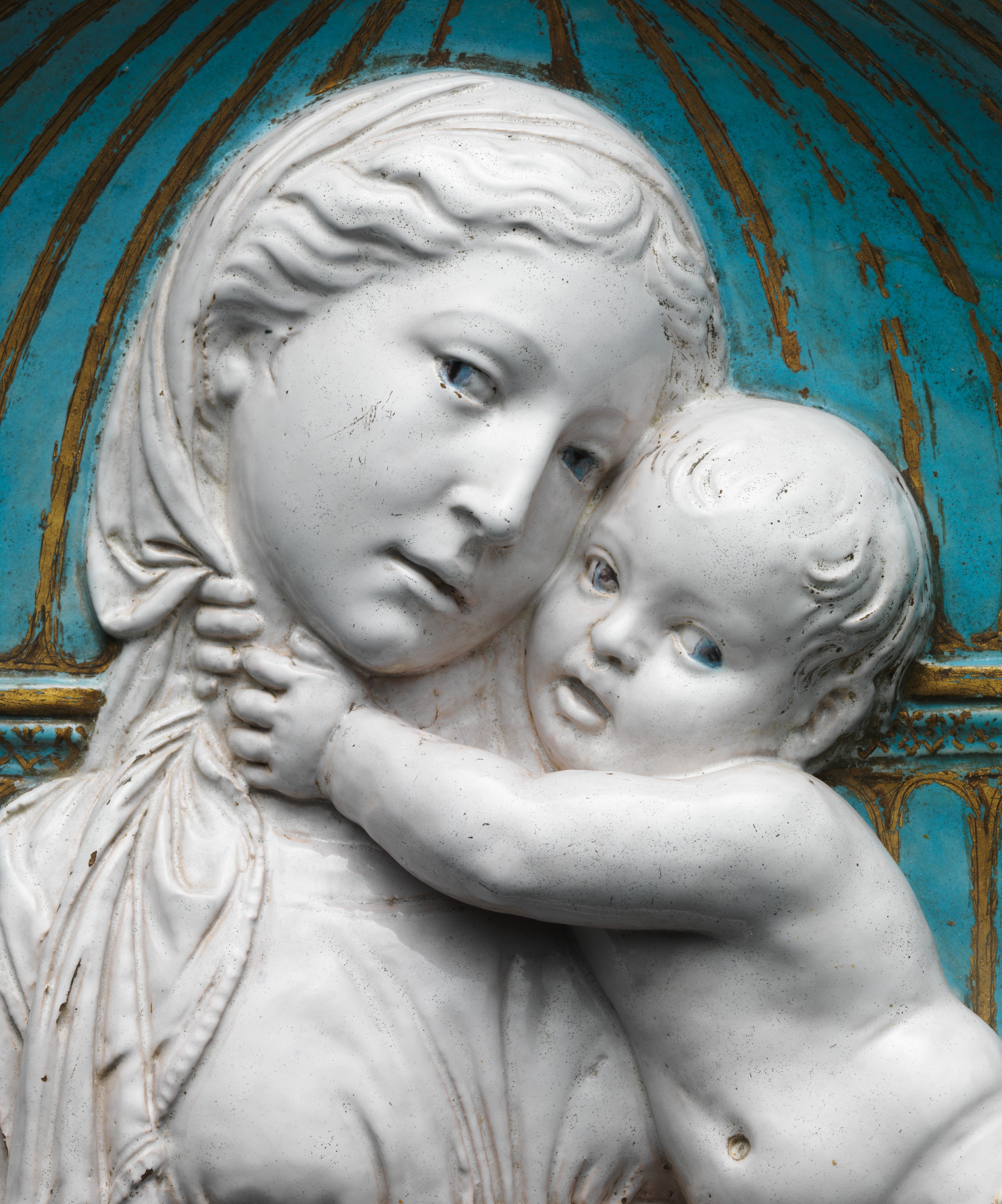Virgin and Child in a niche
Luca della Robbia Italian
One of the most distinguished sculptors of the early Renaissance, Luca della Robbia created famous works in marble, such as the Cantoria (Singing Choir) for the organ loft of Florence Cathedral, and in bronze, such as the doors of the North Sacristy of the same church. His name is, however, most closely identified — and indeed nearly synonymous with — sculpture in tin-glazed terracotta. In this medium he specialized in images of the Madonna and Child, particularly for private devotions, and began a practice of reproducing them in casts, which members of his family and large workshop continued into the sixteenth century.
The Bliss Madonna, a glazed terracotta known in one other example (see below), is a quintessential Luca della Robbia work. Seen in half-length, the Virgin occupies a niche defined by gold-painted ribs against a turquoise ground. The frame is embellished with a floral design, and its upper corners are emblazoned with the Bartorelli and Baldi coats of arms, likely denoting a marriage between those Florentine families.[1] Turquoise is signally rare as a ground color but encountered in other Della Robbia floral reliefs. As if shying from an onlooker, the Christ Child stands on the edge of the niche and leans in toward his mother, embracing her neck, while she supports him with one hand on a foot and the other on his hip. Their heads touch, but their blue gray eyes look out at the viewer. The Virgin’s thick mantle and robe and lighter veil envelop her and offer protection to the Child, who steps on her mantle and entwines the veil with his hands.
So popular were images of the Madonna and Child that artists sought to vary and polish their composition. Luca appears to have first essayed the half-length Madonna holding a standing Child in a relatively unrefined work in stucco (Musée Jacquemart-André, Paris) about 1430. The infant does not lean in as engagingly, his pose is not as dynamic, and he does not move back in space as convincingly as in the Metropolitan’s example. Luca developed that composition about 1450 – 55, producing a type known in several variants as the Genoa Madonna, in which Christ turns to his mother and reaches around her neck, but his right foot is forward and she places her right hand protectively on his waist. The Bliss Madonna shows further improvements in these poses and is more expressive of the emotional bond between the figures. Noting this, John Pope-Hennessy called it "the most beautiful and complex example of applied decoration in Luca della Robbia’s work." [2] Another example in the Museum, in which the figures are roughly twice the size of those seen here and in which the background is blank, reflects Luca’s architectural commissions, as it may have been intended to fill a lunette over a door. [3] It is a forceful representation of the subject, but two very different qualities, intimacy and modest scale, are what make the Bliss Madonna so successful. The harmony Luca achieved through successive adjustments to the composition have produced a completely satisfying balance between the figures and between them and the space they occupy.
The only other known variant of the subject (Museum of Fine Arts, Boston) differs slightly in the treatment of the mantle and is not quite as refined in its modeling, yet it seems to have come from the same mold as the Bliss Madonna. Some earlier scholars disagreed whether the reliefs should be ascribed to Luca or to his nephew Andrea, but in 1914 the Della Robbia authority Allan Marquand attributed them to Luca and advanced the dating from 1440 – 50, which Wilhelm von Bode had proposed, to about 1460, a date that Pope-Hennessy in turn accepted.
[Ian Wardropper. European Sculpture, 1400–1900, in the Metropolitan Museum of Art. New York, 2011, no. 4, pp. 20–22.]
Footnotes:
1. Allan Marquand. Luca della Robbia. Princeton Monographs in Art and Archaeology 3. Princeton and London, 1914, p. 157, suggests this, but no record of such a marriage has yet been found.
2. John Pope-Hennessy. Luca della Robbia. Itahca, N.Y., 1980, p. 255, no. 40.
3. It was formerly in the Altman collection (acc. no. 14.40.685).
Due to rights restrictions, this image cannot be enlarged, viewed at full screen, or downloaded.
This artwork is meant to be viewed from right to left. Scroll left to view more.



